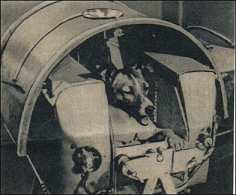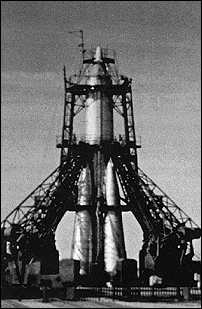Sputnik-2, more news from distant history
Sven Grahn
 A
space history paper "surfaces" in Houston!
A
space history paper "surfaces" in Houston!
At the World Space
Congress
in Houston in October 2002 a very interesting paper (1)
about Sputnik-2 appeared written by by Dimitri C. Malashenkov from the
Institute for Biological problems in Moscow. The following details were
given about the design of the spacecraft:
-
The life-support
system and
the food was designed for a 7-day flight
-
The food and water for
the dog
was in jelly form
-
There was a CO2
absorbing
device as well as an O2 generator and device to avoid oxygen
poisoning.
-
A fan was set to be
activated
above 15oC to keep the dog cool.
-
Metal "chains" keep
the dog
from moving except for standing, sitting or lie down. It could not turn
around in the cabin.
-
There was also a
"sewage" device
of a character not further elaborated on.
-
The following
parameters were
telemetered:
-
Respiration rate
-
Maximum arterial
pressure
-
Electrocardiogram
-
"Actogram" showing
movements
of the dog
There had been work done
to adapt a group of dogs to conditions in the tight cabin. This had led
to keeping dogs in gradually smaller cages for periods up to
15-20
days. In general, it seems that long confinement led untrained dogs to
neither urinate nor release solid wastes, which made the dogs restless
and caused their general condition to decay. Laxatives did not help,
only
long training did. All these preparations must have been far in advance
of the decree of 12 October 1957 to carry out the flight of the dog.
(See
article entitled: Sputnik
2 - was it really built in less than a month?) Pre-flight
experiments
with launch phase stress like vibrations caused the pulse to double and
the blood pressure to increase by 30-65 mm Hg.
There were three dogs
selected
for the Sputnik-2 flight: Albina, Laika and Mushka. Albina had flown
twice
on a high altitude rocket, so it was the "stand-in" for Laika, while
Mushka
was a "technological dog" used to test instrumentation and life
support.
(According to (2) the first being to travel
to outer space was a female part-Samoyed terrier originally named
Kudryavka
[Little Curly] but later renamed Laika [Barker]).
Pre-launch
physiological
parameters of Laika were normal, but pulse rate went up by a factor
three
at launch and at peak acceleration the respiration rate had increased
3-4
times above pre-launch values. At the start of weightlessness the pulse
rate decreased to values near the pre-launch rate. However, it took
three
times longer than after a centrifuge ride on the ground to return to
pre-launch
values. Electrocardiogram traces also approached normal as the flight
continued.
However, telemetry
showed
that temperature and humidity in the dog cabin increased gradually.
After
5-7 hours into the flight no physiological parameters were transmitted
and on the fourth orbit it was impossible to obtain any data on the
condition
of the dog.

Post-flight simulations
showed
that Laika probably overheated an died on the third or fourth orbit. As
the author writes: "It was practically impossible to create a
reliable
system of a temperature control in such small [sic] term". There is
no mention of any problem with the nose shroud that could have helped
make
the temperature control problem worse.
Previously, it has been
thought
that Laika survived four days in space and perhaps for a week when the
transmitters (on shortwaves) of Sputnik-2 went silent. Actually, it
seems that she survived for only 5-7 hours! But that was enough to
prove that a living organsism could tolerate a long time in
weightlessness.
Other notes about
Sputnik-2
-
 According
to (3) Laika, like many earlier
space
dogs, was "recruited" from the streets of Moscow. Named Kudryavka
(Little
Curly) by her trainers, she was officially renamed Laika (Barker) after
her breed. Dogs of this breed were ideal for such flights due to their
small size and even temperament. Strays from the Moscow streets were
chosen
since they were generally strong and could endure the hardships of
hunger
and extreme cold. In case Laika was not fit to make the flight, she had
a backup named Albina. A third dog, named Muskha, was to serve as part
of the ground test team but she was removed after she would not eat
properly.
According
to (3) Laika, like many earlier
space
dogs, was "recruited" from the streets of Moscow. Named Kudryavka
(Little
Curly) by her trainers, she was officially renamed Laika (Barker) after
her breed. Dogs of this breed were ideal for such flights due to their
small size and even temperament. Strays from the Moscow streets were
chosen
since they were generally strong and could endure the hardships of
hunger
and extreme cold. In case Laika was not fit to make the flight, she had
a backup named Albina. A third dog, named Muskha, was to serve as part
of the ground test team but she was removed after she would not eat
properly.
-
My friend Richard
Flagg, now
living in Hawaii wrote recently (4): "I
recall monitoring signals from Sputnik
-2
as
did a friend across the street in Clearwater [Florida]. He got a
QSL card (5) - with a picture of Laika.
I always wished that I had gotten one. Oh well."
-
Sergei Korolev, the
chief designer
of the R-7 rocket and the early sputniks returned to Moscow on October
5, 1957 - the day after the launch of Sputnik-1. In a conversation with
Khrushchev, the Soviet leader at the time, held immediately upon
Korolev's
return to Moscow - Korolev suggested launching a dog-carrying satellite
in time for the anniversary (40 th) of the Great October
Socialist
Revolution on November 7. Khrushchev ordered his deputy, Frol
Kozlov
to oversee the effort and the next day a top level meeting with all
chief
designers was called to organize the project (6).
When could all of this have happened? Could the meeting with Khrushchev
have happened on 5 October and the meeting with chief designers on 6
October?
This could be so, because newspaper reports in the west were saying
already
on 7 October that the next satellite would carry animals. And on 11
October
the next launch was reported to be planned to take place in a month's
time"
(See my web article
"The
veracity of early rumours about Soviet space ventures")
- Laika was put inside
the satellite
on October 31, 1957 - four days before launch! Not only did she have to
suffer in space, she also had to suffer during launch preparations [See
picture above right] : "... Laika was put in the satellite
container
at mid-day on October 31, and by nighttime, the payload had ben
attached
to the booster rocket. Temperatures at Tyura-Tam were very cold at the
time, and the container was heated via a special hose connected to an
air
conditioner during the preparations for launch. Yazdovskiy, the de
facto
head of all biomedical operations, asked two of his assistants to keep
a constant watch on Laika through the stacking procedures. ..." (6).
References and footnotes
-
Malashenkov,
Dimitri C, "Some Unknown Pages of the Living Organism's First Orbital
Flight",
Paper IAC-02-IAA.2.2.05, 53rd International Astronautical Concress,
10-19
October 2002, Houston, Texas.
- National
Space Science Data Center (article on Sputnik-2)
-
LePage,
Andrew J., Sputnik 2: The
First Animal in Orbit. Spaceviews Nov 1997 articles.
-
E-mail
from
Richard S Flagg dated 27 October 2002.
-
A
QSL-card
is a station verification report. QSL is a radio amateur "Q signal" and
means "I am acknowledging receipt"
-
Siddiqi,
Asif, "Challenge to Apollo", NASA SP-2000-4408, pp.172

 Back
to Space History Notes
Back
to Space History Notes
 A
space history paper "surfaces" in Houston!
A
space history paper "surfaces" in Houston! A
space history paper "surfaces" in Houston!
A
space history paper "surfaces" in Houston!
 According
to (3) Laika, like many earlier
space
dogs, was "recruited" from the streets of Moscow. Named Kudryavka
(Little
Curly) by her trainers, she was officially renamed Laika (Barker) after
her breed. Dogs of this breed were ideal for such flights due to their
small size and even temperament. Strays from the Moscow streets were
chosen
since they were generally strong and could endure the hardships of
hunger
and extreme cold. In case Laika was not fit to make the flight, she had
a backup named Albina. A third dog, named Muskha, was to serve as part
of the ground test team but she was removed after she would not eat
properly.
According
to (3) Laika, like many earlier
space
dogs, was "recruited" from the streets of Moscow. Named Kudryavka
(Little
Curly) by her trainers, she was officially renamed Laika (Barker) after
her breed. Dogs of this breed were ideal for such flights due to their
small size and even temperament. Strays from the Moscow streets were
chosen
since they were generally strong and could endure the hardships of
hunger
and extreme cold. In case Laika was not fit to make the flight, she had
a backup named Albina. A third dog, named Muskha, was to serve as part
of the ground test team but she was removed after she would not eat
properly.